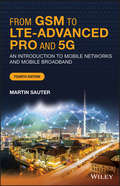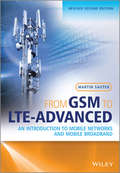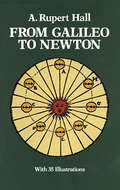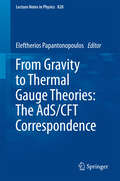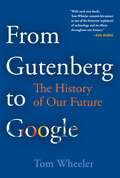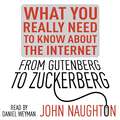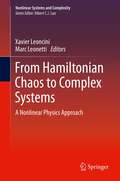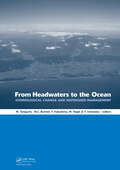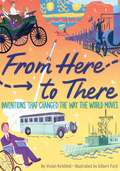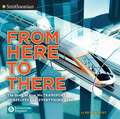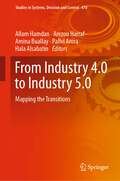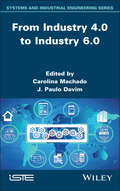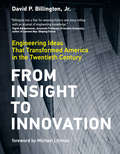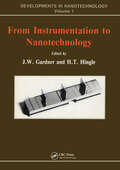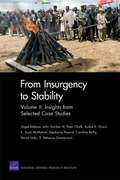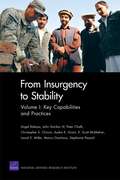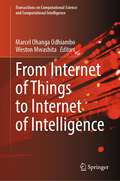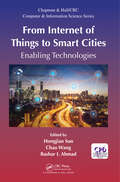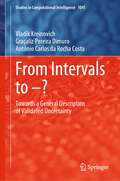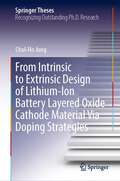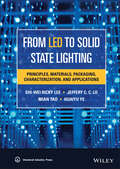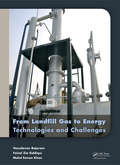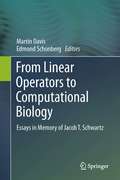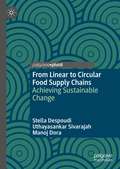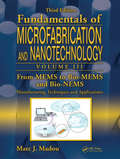- Table View
- List View
From GSM to LTE-Advanced Pro and 5G: An Introduction to Mobile Networks and Mobile Broadband
by Martin SauterA revised edition of the text that offers a comparative introduction to global wireless standards, technologies, and their applications The revised and updated fourth edition of From GSM to LTE-Advanced Pro and 5G: An Introduction to Mobile Networks and Mobile Broadband offers an authoritative guide to the technical descriptions of the various wireless technologies currently in use. The author—a noted expert on the topic—explains the rationale behind their differing mechanisms and implementations while exploring the advantages and limitations of each technology. The fourth edition reflects the significant changes in mobile network technology that have taken place since the third edition was published. The text offers a new chapter on 5G NR that explores its non-standalone and standalone architecture. In the Wi-Fi chapter, additional sections focus on the new WPA3 authentication protocol, the new 802.11ax air interface and protocol extensions like 802.11k and 11v for meshed networks. This important book: Presents the various systems based on the standards, their practical implementation and design assumptions, and their performance and capacity Provides an in-depth analysis of each system in practice Offers an updated edition of the most current changes to mobile network technology Includes questions at the end of each chapter and answers on the accompanying website that make this book ideal for self-study or as course material Written for students and professionals of wireless technologies, the revised fourth edition of From GSM to LTE-Advanced Pro and 5G provides an in-depth review and description of the most current mobile networks and broadband.
From GSM to LTE-Advanced: An Introduction to Mobile Networks and Mobile Broadband
by Martin SauterThis revised edition of Communication Systems from GSM to LTE: An Introduction to Mobile Networks and Mobile Broadband Second Edition (Wiley 2010) contains not only a technical description of the different wireless systems available today, but also explains the rationale behind the different mechanisms and implementations; not only the ‘how’ but also the ‘why’. In this way, the advantages and also limitations of each technology become apparent. Offering a solid introduction to major global wireless standards and comparisons of the different wireless technologies and their applications, this edition has been updated to provide the latest directions and activities in 3GPP standardization up to Release 12, and importantly includes a new chapter on Voice over LTE (VoLTE). There are new sections on Building Blocks of a Voice Centric Device, Building Blocks of a Smart Phone, Fast Dormancy, IMS and High-Speed Downlink Packet Access, and Wi-Fi-Protected Setup. Other sections have been considerably updated in places reflecting the current state of the technology. • Describes the different systems based on the standards, their practical implementation and design assumptions, and the performance and capacity of each system in practice is analyzed and explained • Questions at the end of each chapter and answers on the accompanying website make this book ideal for self-study or as course material
From Galileo to Newton
by A. Rupert HallThe near century (1630-1720) that separates the important astronomical findings of Galileo Galilei (1564-1642) and the vastly influential mathematical work of Sir Isaac Newton (1642-1727) represents a pivotal stage of transition in the history of science. As a result of the raging intellectual battle between tradition and innovation that began in the fifteenth century, science was penetrated by a new outlook that placed emphasis on experiment and observation. Galileo showed the promise of its new methods of discovery; Newton brought out their full force and effect. Galileo suffered from an attempt to censure scientific inquiry; Newton showed how science could discover the universal laws of nature. The triumph of this new outlook marked the birth of modern science.From Galileo to Newton describes those new patterns of thought that emerged during this time of great excitement and widespread controversy. It discusses the discoveries revealed by telescope and microscope in the work of Huygens and Leeuwenhoek, and the new speculations to which these gave rise; Boyle's attempts to include chemical experiments within a rational theory of matter, and those begun by Descartes to explain the workings of the body on the basis of chemical and physical principles; and the revolutionary ideas in astronomy that generated the transition from the Ptolemaic concept of the universe to the Copernican and the subsequent acceptance of the heliostatic system.Since the dawn of civilization man has tried to find logic in the mysterious and order in the chaotic. From Galileo to Newton will appeal to anyone who wants to know what modern science is all about and how it came into being. One of the foremost authorities on the history of science, Professor Hall is not only a scholar of great learning and originality, he also writes with clarity, liveliness, and a keen biographical sense.
From Gravity to Thermal Gauge Theories: The AdS/CFT Correspondence
by Eleftherios PapantonopoulosThe AdS/CFT correspondence is a powerful tool in studying strongly coupled phenomena in gauge field theories, using results from a weakly coupled gravity background studied in the realm of string theory. AdS/CFT was first successfully applied to the study of phenomena such as the quark-gluon plasma produced in heavy ions collisions. Soon it was realized that its applicability can be extended, in a more phenomenological approach, to condensed matter systems and to systems described by fluid dynamics. The set of tutorial reviews in this volume is intended as an introduction to and survey of the principle of the AdS/CFT correspondence in its field/string theoretic formulation, its applicability to holographic QCD and to heavy ions collisions, and to give a first account of processes in fluid dynamics and condensed matter physics, which can be studied with the use of this principle. Written by leading researchers in the field and cast into the form of a high-level but approachable multi-author textbook, this volume will be of benefit to all postgraduate students, and newcomers from neighboring disciplines wishing to find a comprehensive guide for their future research.
From Gutenberg To Google: The History Of Our Future
by Tom WheelerIn an era of seemingly instant change, it's easy to think that today's revolutions--in communications, business, and many areas of daily life--are unprecedented. Today's changes may be new and may be happening faster than ever before. But our ancestors at times were just as bewildered by rapid upheavals in what we now call "networks"--the physical links that bind any society together. <p><p> In this fascinating book, former FCC chairman Tom Wheeler brings to life the two great network revolutions of the past and uses them to help put in perspective the confusion, uncertainty, and even excitement most people face today. The first big network revolution was the invention of movable-type printing in the fifteenth century. This book, its millions of predecessors, and even such broad trends as the Reformation, the Renaissance, and the multiple scientific revolutions of the past 500 years would not have been possible without that one invention. The second revolution came with the invention of the telegraph early in the nineteenth century. Never before had people been able to communicate over long distances faster than a horse could travel. Along with the development of the world's first high-speed network--the railroad--the telegraph upended centuries of stability and literally redrew the map of the world. <p> Wheeler puts these past revolutions into the perspective of today, when rapid-fire changes in networking are upending the nature of work, personal privacy, education, the media, and nearly every other aspect of modern life. But he doesn't leave it there. Outlining "What's Next," he describes how artificial intelligence, virtual reality, blockchain, and the need for cybersecurity are laying the foundation for a third network revolution.
From Gutenberg to Zuckerberg: What You Really Need to Know About the Internet
by John NaughtonJohn Naughton is the Observer's â??Networker' columnist, a prominent blogger, and Vice-President of Wolfson College, Cambridge. The Times has said that his writings, "[it] draws on more than two decades of study to explain how the internet works and the challenges and opportunities it will offer to future generations," and Cory Doctrow raved that "this is the kind of primer you want to slide under your boss's door." In From Gutenberg to Zuckerberg, Naughton explores the living history of one of the most radically transformational technologies of all time. From Gutenberg to Zuckerberg is a clear-eyed history of one of the most central, and yet most taken-for-granted, features of modern life: the internet. Once a technological novelty and now the very plumbing of the Information Age, the internet is something we have learned to take largely for granted. So, how exactly has our society become so dependent upon a utility it barely understands? And what does it say about us that this is so? While explaining in highly engaging language the way the internet works and how it got to be the way it is, technologist John Naughton has distilled the noisy chatter surrounding the technology's relentless evolution into nine essential areas of understanding. In doing so, he affords readers deeper insight into the information economy and supplies the requisite knowledge to make better use of the technologies and networks around us, highlighting some of their fascinating and far-reaching implications along the way.(P)2013 Quercus Editions Ltd
From Hamiltonian Chaos to Complex Systems: A Nonlinear Physics Approach
by Xavier Leoncini Marc LeonettiFrom Hamiltonian Chaos to Complex Systems: A Nonlinear Physics Approach collects contributions on recent developments in non-linear dynamics and statistical physics with an emphasis on complex systems. This book provides a wide range of state-of-the-art research in these fields. The unifying aspect of this book is demonstration of how similar tools coming from dynamical systems, nonlinear physics, and statistical dynamics can lead to a large panorama of research in various fields of physics and beyond, most notably with the perspective of application in complex systems.
From Headwaters to the Ocean: Hydrological Change and Water Management - Hydrochange 2008, 1-3 October 2008, Kyoto, Japan
by Makoto Taniguchi Martin Haigh William C. Burnett Yoshihiro Fukushima Yu UmezawaThe vulnerability of water resources due to climate change and human activities is globally increasing. The phenomenon of hydrological change is complicated because of the combinations and interactions between natural climate fluctuation, global warming and human activities including changes in land utilization. The impact areas of hydrological cha
From Here to There: Inventions That Changed the Way the World Moves
by Gilbert Ford Vivian KirkfieldCelebrating the invention of vehicles, this collective biography tells the inspiring stories of the visionaries who changed the way we move across air, water, and land. Perfect for fans of Mistakes that Worked and Girls Think of Everything.In a time when people believed flying was impossible, Joseph and Etienne Montgolfier proved that the sky wasn&’t the limit. When most thought horseback was the only way to race, Bertha and Karl Benz fired up their engines. From the invention of the bicycle and the passenger steam locomotive, to the first liquid-fuel propelled rocket and industrial robot, inventors across the world have redefined travel. Filled with informative sidebars and colorful illustrations, this collective biography tells the story of the experiments, failures, and successes of visionaries who changed the way the world moves.
From Here to There: The Story of How We Transport Ourselves and Everything Else
by Hp NewquistThis lively history of transportation follows our fascinating route from primitive technology like sandals to driverless cars and beyond! Since humans first stood upright, we've been on the move. Need food? Water? Land? A place to live? Survival depends upon motion. For thousands of years, people have devised ways to move faster, farther, and more comfortably. Their inventions—shoes, skis, the rudder, the wheel, engines, rockets—have had an enormous impact on how and where human beings live and thrive. When human beings get a move on, change happens:- The wheel, probably first used in the Middle East around 6,000 years ago, meant building and trading supplies could be moved more easily—whole civilizations rolled out.- The Vikings sailed far and wide because they used a keel on their longships. - Horse-and-carriage gridlock gave rise to subways. - The bicycle changed the world for women in terms of freedom and fashion.- Drones and driverless cars are the future . . . coming sooner than we think. Award-winning author HP Newquist explores the transportation inventions and technologies that have transformed the way we experience the world around us. It’s a fascinating journey!
From Industry 4.0 to Industry 5.0: Mapping the Transitions (Studies in Systems, Decision and Control #470)
by Allam Hamdan Arezou Harraf Pallvi Arora Amina Buallay Hala AlsabatinThis book aims at bringing together global researchers to generate thought on how this transition from Industry 4.0 to Industry 5.0 could make a difference to the globe for larger good. The collaboration and interaction between man and machine has given rise to Industry 5.0. With the prime objective of Industry 5.0 to create a benefit for the human beings while tapping on to the advantage of Industry 4.0, in no case, does it replace what has already been achieved. In fact, it brings to light what can be done in order to make life better. While Industry 4.0 offered extraordinary technological advancement, Industry 5.0 reasons out that technology alone is not sufficient to answer everything or provide a solution, but it is an amalgamation of both machine and human interaction to create that difference. In fact, with the impact of widespread digitalization that has led to dehumanization of the industrial makeup, the interest of global researchers has increased toward mapping how the human creativity and brainpower can be reconciled with the intelligent systems that can enhance process efficiency.Industry 5.0 has touched upon some of those key domains which are of much concern and debate globally including resilience (both business and cyber), environment and sustainability, diversity and inclusion, values and ethics, vision and purpose, circular economy, understanding the human–machine collaboration and the ‘human-touch’ in the production process.This transition that has taken place in moving from Industry 4.0 to Industry 5.0 has essentially created a need to pay cognizance to the role of ‘human’ in the process which creates an enhanced focus toward the right kind of skills and competencies, identification of training and developmental needs, talent acquisition and management, safety and wellbeing, future of work as well as hybrid working models.Undeniably, the pace with which Industry 4.0 has been accelerating has bypassed the first three industrial revolutions, which is definitely a consequence of the fast introduction of new and cutting-edge technologies. While organizations are already in analyzing the context, mapping this transition and the flow of activities from Industry 4.0 to 5.0 is gaining attention as Industry 4.0 lacked personalization and customization. This co-existence of man and machine creates a pathway for newer prospects and opportunities to emerge and expand possibilities of personalization with the empowerment of ‘human’ in the production process.This lays the foundation for this book. This book adopts a forward-looking approach by bringing in research and contributions that facilitate in mapping the consereasons, consequences and solutions for ‘man+machine’ across industries. This book serves as a guide not just to academia but also to the industry to adopt suitable strategies that offer insights into global best practices as well as the innovations in the domain.
From Industry 4.0 to Industry 6.0 (ISTE Invoiced)
by J. Paulo Davim Carolina MachadoIndustry 4.0 marked a revolution in industrial processes, introducing connectivity and digitalization as key elements to improve efficiency and productivity. However, technological evolution moves ever forward, and now the prospect of Industry 6.0 has emerged, a new era that promises to radically transform the way we view industrial production. Indeed, Industry 6.0 looks to go further, introducing revolutionary concepts that will redefine how we view industrial production. Conscious of this reality, From Industry 4.0 to Industry 6.0 highlights the importance and impact this technological evolution will have on the way today's organizations develop into proactive, innovative and competitive agents. Organized into eight chapters, From Industry 4.0 to Industry 6.0 can be used by various potential stakeholders, not only academics and researchers, but managers, engineers, practitioners and other professionals who develop their professional activity in different areas of management and engineering.
From Insight to Innovation: Engineering Ideas That Transformed America in the Twentieth Century
by David P. BillingtonThe engineering ideas behind key twentieth-century technical innovations, from great dams and highways to the jet engine, the transistor, the microchip, and the computer.Technology is essential to modern life, yet few of us are technology-literate enough to know much about the engineering that underpins it. In this book, David P. Billington, Jr., offers accessible accounts of the key twentieth-century engineering innovations that brought us into the twenty-first century. Billington examines a series of engineering advances--from Hoover Dam and jet engines to the transistor, the microchip, the computer, and the internet--and explains how they came about and how they work.
From Instrumentation to Nanotechnology
by J.W. GardnerAddressed to physical and chemical scientists and engineers, this book provides information on the design, manufacture, and assessment of components with critical dimensions or critical tolerances in the 0.1-100 nanometer range. Such tiny parts are now used in automobile engines, cassette players, and other common products. The 16 lectures presented are from an advanced vacation school on instrumentation and nanotechnology in Warwick, England, September 1990. Among the topics are signal processing, ultrasonic sensors, and nanoactuators for controlled displacements..
From Insurgency to Stability: Insights from Selected Case Studies
by Peter Chalk Angel Rabasa John Gordon Audra K. Grant K. Scott McmahonThis book examines six case studies of insurgencies from around the world to determine the key factors necessary for a successful transition from counterinsurgency to a more stable situation. The authors review the causes of each insurgency and the key players involved, and examine what the government did right--or wrong--to bring the insurgency to an end and to transition to greater stability.
From Insurgency to Stability: Key Capabilities and Practices
by Peter Chalk Angel Rabasa Christopher S. Chivvis John Gordon Audra K. GrantThis book identifies the procedures and capabilities that the U.S. Department of Defense, other agencies of the U.S. government, U.S. allies and partners, and international organizations require in order to support the transition from counterinsurgency, when the military takes primary responsibility for security and economic operations, to stability and reconstruction, when police and civilian government agencies take the lead.
From Internet of Things to Internet of Intelligence (Transactions on Computational Science and Computational Intelligence)
by Marcel Ohanga Odhiambo Weston MwashitaThe book focuses on the open challenges associated with the convergence of the Internet of Things and Artificial Intelligence, as accommodated in 6G architecture. The authors discuss how in many fields, such as Natural Language Processing (NLP), interactive computer games, robotics, and multiuser virtual environments, this convergence is likely to have enormously benefits, from artificial intelligence mimicking human intelligence, attempting to simulate human intelligence, and producing a new intelligent machine capable of processing information with human consciousness, behaviour, and thinking integrated with appropriate algorithms. The book provides users with the fundamentals of IoT architecture, AI technology, and the architecture of AI and IoT converged networks. Furthermore, to provide hands-on experience with the technology, some proposed systems are discussed, along with their applications in various sectors such as healthcare, transportation, smart homes, production, manufacturing, renewable energy and agriculture. The book will discuss new technological advances, current research trends, and industry requirements. Discussed open challenges in the field will motivate researchers and stakeholders in industry to provide solutions, with some presented in the book to help spark ideas.
From Internet of Things to Smart Cities: Enabling Technologies (Chapman & Hall/CRC Computer and Information Science Series)
by Chao Wang Hongjian Sun Bashar AhmadFrom Internet of Things to Smart Cities: Enabling Technologies explores the information and communication technologies (ICT) needed to enable real-time responses to current environmental, technological, societal, and economic challenges. ICT technologies can be utilized to help with reducing carbon emissions, improving resource utilization efficiency, promoting active engagement of citizens, and more. This book aims to introduce the latest ICT technologies and to promote international collaborations across the scientific community, and eventually, the general public. It consists of three tightly coupled parts. The first part explores the involvement of enabling technologies from basic machine-to-machine communications to Internet of Things technologies. The second part of the book focuses on state of the art data analytics and security techniques, and the last part of the book discusses the design of human-machine interfaces, including smart home and cities. Features Provides an extended literature review of relevant technologies, in addition to detailed comparison diagrams, making new readers be easier to grasp fundamental and wide knowledge Contains the most recent research results in the field of communications, signal processing and computing sciences for facilitating smart homes, buildings, and cities Includes future research directions in Internet of Things, smart homes, smart buildings, smart grid, and smart cities Presents real examples of applying these enabling technologies to smart homes, transportation systems and cities With contributions from leading experts, the book follows an easy structure that not only presents timely research topics in-depth, but also integrates them into real world applications to help readers to better understand them.
From Intervals to –?: Towards a General Description of Validated Uncertainty (Studies in Computational Intelligence #1041)
by Vladik Kreinovich Graçaliz Pereira Dimuro Antônio Carlos da Rocha CostaThis book is about methodological aspects of uncertainty propagation in data processing. Uncertainty propagation is an important problem: while computer algorithms efficiently process data related to many aspects of their lives, most of these algorithms implicitly assume that the numbers they process are exact. In reality, these numbers come from measurements, and measurements are never 100% exact. Because of this, it makes no sense to translate 61 kg into pounds and get the result—as computers do—with 13 digit accuracy. In many cases—e.g., in celestial mechanics—the state of a system can be described by a few numbers: the values of the corresponding physical quantities. In such cases, for each of these quantities, we know (at least) the upper bound on the measurement error. This bound is either provided by the manufacturer of the measuring instrument—or is estimated by the user who calibrates this instrument. However, in many other cases, the description of the system is more complex than a few numbers: we need a function to describe a physical field (e.g., electromagnetic field); we need a vector in Hilbert space to describe a quantum state; we need a pseudo-Riemannian space to describe the physical space-time, etc. To describe and process uncertainty in all such cases, this book proposes a general methodology—a methodology that includes intervals as a particular case. The book is recommended to students and researchers interested in challenging aspects of uncertainty analysis and to practitioners who need to handle uncertainty in such unusual situations.
From Intrinsic to Extrinsic Design of Lithium-Ion Battery Layered Oxide Cathode Material Via Doping Strategies (Springer Theses)
by Chul-Ho JungThis book addresses the comprehensive understanding of Ni-rich layered oxide of lithium-ion batteries cathodes materials, especially focusing on the effect of dopant on the intrinsic and extrinsic effect to its host materials. This book can be divided into three parts, that is, 1. overall understanding of layered oxide system, 2. intrinsic effect of dopant on layered oxides, and 3. extrinsic effect of dopant on layered oxides. To truly understand and discover the fundamental solution (e.g. doping) to improve the Ni-rich layered oxides cathodic performance, understanding the foundation of layered oxide degradation mechanism is the key, thus, the first chapter focuses on discovering the true degradation mechanisms of layered oxides systems. Then, the second and third chapter deals with the effect of dopant on alleviating the fundamental degradation mechanism of Ni-rich layered oxides, which we believe is the first insight ever been provided. The content described in this book will provide research insight to develop high-performance Ni-rich layered oxide cathode materials and serve as a guide for those who study energy storage systems.
From LED to Solid State Lighting: Principles, Materials, Packaging, Characterization, and Applications
by S. W. Lee Jeffery C. Lo Mian Tao Huaiyu YeA comprehensive reference including practical, hands-on exercises and data of experimental studies, written by leading researchers in the field• An introductory/intermediate level treatment including practical, hands-on exercises and data of experimental studies, written by leading researchers in the field• The authors lead a LED packaging R&D center with an industrial grade prototyping line and state-of-the-art facilities for materials/optical/electrical/thermal characterization. A substantial amount of technical contents in this book is based on the hands-on experience and experimental practices of the authors• The manufacture of LED-based luminaries for lighting is a huge area and there is a need for a comprehensive book instructing engineers and designers in the lighting industry• Includes packaging LED components such as interconnection, phosphor deposition, encapsulation, thermal management and reliability, making this an excellent reference and background reading for engineers and researchers
From Landfill Gas to Energy: Technologies and Challenges
by Vasudevan Rajaram Faisal Zia Siddiqui M. Emran KhanConverting old landfills to energy producing sites, while capturing emitted greenhouse gases, has faced numerous technical, financial and social challenges and developments lately. Also, the re-mining of landfills to recover useful land in dense urban areas and proper landfill closure has been a subject of discussion and investigation. Designed as
From Linear Operators to Computational Biology
by Martin Davis Edmond SchonbergIn his rich and varied career as a mathematician, computer scientist, and educator, Jacob T. Schwartz wrote seminal works in analysis, mathematical economics, programming languages, algorithmics, and computational geometry. In this volume of essays, his friends, students, and collaborators at the Courant Institute of Mathematical Sciences present recent results in some of the fields that Schwartz explored: quantum theory, the theory and practice of programming, program correctness and decision procedures, dextrous manipulation in Robotics, motion planning, and genomics. In addition to presenting recent results in these fields, these essays illuminate the astonishingly productive trajectory of a brilliant and original scientist and thinker.
From Linear to Circular Food Supply Chains: Achieving Sustainable Change
by Stella Despoudi Uthayasankar Sivarajah Manoj DoraThis book aims to provide the reader with an understanding of the concept of the circular economy, in relation to food supply chains. The current food supply chain system, based upon the linear supply chain model, is unquestionably unsustainable: make, use, dispose. The circular supply chain model, on the other hand, aims to keep resources in use for as long as possible, while regenerating products/materials at the end of their service life. In short: reduce, reuse, recycle.This book puts forwards the circular economy as an alternative to the traditional supply chain management models. The circular economy aims to minimise material, energy and environmental damage without restricting economic growth and social and technological progress. It involves transition to renewable energy sources, and it builds on economic, natural and social capital. This shortform monograph will appeal to academics working in the fields of supply chain logistics, operation management, agricultural management, and sustainability more broadly.Dr. Stella Despoudi is Lecturer in Operations and Supply Chain Management at Aston University, UK and Adjunct Lecturer in Supply Chain Management at University of Western Macedonia, Greece.Prof. Uthayasankar Sivarajah is Head of School of Management and Professor of Technology Management and Circular Economy at the School of Management, University of Bradford, UK.Dr Manoj Dora is Director of Collaborative Projects and Outreach at Brunel Business School, UK. Manoj's areas of specialisation are Sustainable Value Chain and Quality Management, with a focus on Lean Six Sigma in the agro-food sector.
From MEMS to Bio-MEMS and Bio-NEMS: Manufacturing Techniques and Applications
by Marc J. MadouFrom MEMS to Bio-MEMS and Bio-NEMS: Manufacturing Techniques and Applications details manufacturing techniques applicable to bionanotechnology. After reviewing MEMS techniques, materials, and modeling, the author covers nanofabrication, genetically engineered proteins, artificial cells, nanochemistry, and self-assembly. He also discusses scaling la
